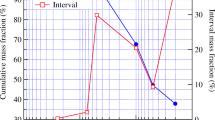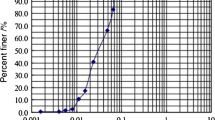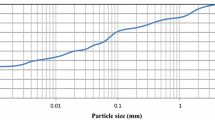Abstract
Expansive soils for residential projects are often treated with liquid ionic soil stabilizer (LISS) using deep pressurized injection method. Liquid ionic soil stabilizers have a long history of application in practice. However, there is limited knowledge and experimental evidence of their stabilization mechanism and effectiveness. This paper summarizes the research that investigated the effects of liquid ionic stabilizers on key engineering properties of a highly expansive clay from Carrollton, Texas, through comprehensive physical and mechanical testing and microscopic observation of untreated and treated soils. Test results before and after treatment were analyzed for two different treatment ratios: 1:300 and 1:150, showing a 53% swell reduction for treated soil compacted at the optimum moisture content (OMC) for treated soil, and 25% swell reduction for treated soil compacted at the OMC for the untreated soil. There was no significant improvement in unconfined compressive strength; noticeable improvement in stiffness was observed. The microscopic analysis showed a marked change in morphology and quantitative element composition, thus suggesting the occurrence of a reasonable degree of stabilization.













Similar content being viewed by others
References
Carter DL, Heilman MD, Gonzalez CL (1965) Ethylene glycol monoethyl ether for determining surface area of silicate minerals. Soil Sci 100(5):356–360
Chapman HD (1965) Cation-exchange capacity. In: Black CA (ed) Methods of soil analysis-Chemical and microbiological properties. SSSA, Madison, pp 891–901
Chittoori BC (2008) Clay mineralogy effects on long-term performance of chemically treated expansive clays. University of Texas at Arlington, Arlington, p 326
Dyal RS, Hendricks SB (1950) Total surface of clays in polar liquids as a characteristic index. Soil Sci 69(6):503–509
He S (2018) Expansive soil treatment with ionic soil stabilizer. Transp Res Rec J Transp Res Board 2672:185–194
Hunter D (1998) Lime-induced heave in sulfate-bearing clay soils. J Geotech Eng 114(2):150–167
Katz LE (2001) Mechanisms of soil stabilization with liquid ionic stabilizer. Transp Res Rec 1757:50–57
Khadka SD (2017) Strength and shrink/swell behaviour of highly plastic clay treated with geopolymer. Transp Res Rec 2672:174–184
Kushwaha P, Chauhan AS, Swami S, Swami BL (2019) Investigating the effects of nanochemical-based ionic stabilizer and co-polymer on soil properties for pavement construction. Int J Geotech Eng. https://doi.org/10.1080/19386362.2019.1635817
Lu X, Xia C (2015) Experimental study of compaction effects and proportion of expansive soil improved by ionic soil stabilizer. In: International conference on advances in energy, environment and chemical engineering (AEECE)
Liu Q, Xiang W, Zhang W, Cui D (2009) Experimental study of ionic soil stabilizer-improves expansive soil. Rock Soil Mech 8:16
Petry T (1997) Performance-based testing of chemical stabilizers. J Transp Res Board 1589:36–41
Rauch AF, Katz LE, Liljestrand HM (2003) An analysis of the mechanisms and efficacy of three liquild chemical soil stabilizers. Research report 1993-1. Center for Transportation Research, University of Texas at Austin, Austin, pp 1–204
Scholen DE (1992) Non-traditional stabilizers. Report FHWA-FLP-92-011
Scholen DE (1995) Stabilizer mechanisms in nonstandard stabilizers. In: Conference proceedings 6: sixth international conference on low-volume roads, vol 2, pp 252–260. TRB, National Research Council, Washington, DC
Sides G, Barden L (1970) The microstructure of dispersed and flocculated samples of kaolinite, illite and montmorillonite. Can Geotech J 8:391–399
Tingle JS (1989) Stabilization mechanisms of non traditional additives. Transp Res Board 1989:59–67
Xiang WC (2010) Theory and practice of ionic soil stabilizer reinforcing special clay. J Earth Sci 21:882–887
Acknowledgements
This study was supported by TX ProChemical Inc. The authors are grateful to Mr. Scott Horn for assistance in the collection of the test soil samples.
Author information
Authors and Affiliations
Corresponding author
Additional information
Publisher's Note
Springer Nature remains neutral with regard to jurisdictional claims in published maps and institutional affiliations.
Rights and permissions
About this article
Cite this article
Gautam, S., Hoyos, L.R., He, S. et al. Chemical Treatment of a Highly Expansive Clay Using a Liquid Ionic Soil Stabilizer. Geotech Geol Eng 38, 4981–4993 (2020). https://doi.org/10.1007/s10706-020-01342-1
Received:
Accepted:
Published:
Issue Date:
DOI: https://doi.org/10.1007/s10706-020-01342-1




